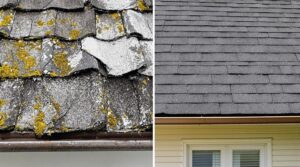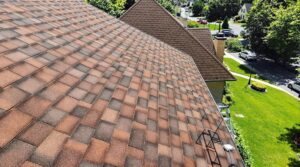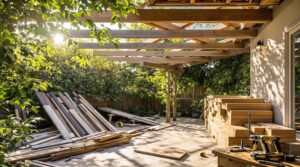Ever wondered what's really included in a roof replacement? Let's talk about plywood – that crucial layer between you and the elements!
Think of your roof deck (that's the plywood) as your home's protective shield. While not every roof replacement needs new plywood, sometimes your shield needs reinforcing. But how do you know when it's time?
Your roof might be screaming for new plywood if:
- You spot mysterious light beams in your attic (those aren't supposed to be there!)
- The roof feels like a sponge cake under your feet (definitely not good!)
- Water stains are playing artist on your ceiling
- Your roof has developed an unwanted roller coaster effect with sagging areas
The investment in new plywood typically runs $4-8 per square foot, covering both materials and installation. Remember, you'll need to factor in those not-so-fun extras like permits and old material disposal.
Pro tip: Before starting your roofing project, get a thorough deck inspection. It's like getting an X-ray for your roof – you'll know exactly what's hiding underneath those old shingles. This knowledge helps you budget accurately and avoid surprise costs mid-project. Plus, it's fantastic documentation for your insurance provider!
Just like you wouldn't build a house on a shaky foundation, you shouldn't lay new shingles on compromised plywood. Smart planning today means a safer, drier tomorrow!
Key Takeaways
Wondering if Your Roof Replacement Includes a Plywood Overhaul?
Let's crack the code on one of roofing's most common mysteries: the plywood puzzle! Think of your roof's plywood as the backbone of your home's protection – it's not always part of the standard replacement package, but it might need some TLC.
When Does Plywood Enter the Picture?
Your existing plywood tells the story. Just like a soggy cardboard box loses its strength, damaged roof decking can't properly support your shingles. Watch out for these red flags:
- Sagging spots (like a hammock where you don't want one)
- Dark water stains
- Spongy areas when walked on
- Attic light peeping through (your roof shouldn't double as a skylight!)
The Money Talk
While basic roof replacement focuses on shingles and underlayment, adding plywood to the mix will bump up your budget. You’re looking at $4-8 per square foot for materials, with skilled labor running $45-75 hourly. Think of it as an investment in your home’s protective armor. Although the initial expense may seem high, the added strength and durability provided by the plywood can lead to long-term savings by reducing the likelihood of leaks and damage. When evaluating the cost of roofing a 3500 sqft house, it’s essential to factor in not only the materials but also the expertise of professional roofers who can deliver a high-quality finish. Ultimately, investing in a robust roofing system enhances your home’s value and protects it from the elements for years to come.
Silver Lining Alert
Got storm damage? Your insurance might have your back! Many policies cover plywood replacement when Mother Nature throws a tantrum. Just make sure to document everything thoroughly – think of it as building your case for a roof rescue mission.
Remember, skipping necessary plywood replacement is like putting new tires on a car with a cracked axle – it might look good initially, but you're setting yourself up for trouble down the road.
Understanding the Role of Plywood in Your Roof Structure
Ever wondered what keeps your shingles from caving in? It's that mighty layer of plywood sheathing working behind the scenes! Think of it as your roof's backbone – it's not just a wooden sheet, but a crucial player in your home's defense system.
Why is plywood such a superstar in roofing? First off, it's like nature's sandwich – layers of wood pressed together to create an incredibly strong barrier. Coming in various thicknesses (typically 3/8" to 3/4"), this versatile material does more than just provide a base for your shingles.
Picture your roof during a windstorm. That plywood layer acts like a shield, distributing those fierce gusts across your entire roof structure instead of letting them pummel one spot. Pretty clever, right?
It's also your roof's personal bodyguard against earthquakes, spreading those seismic forces evenly throughout your home's framework.
What makes plywood special is its cross-laminated design – think of it as wood's version of a bulletproof vest. Unlike single pieces of lumber, it won't split or warp when the weather throws a tantrum.
Plus, when treated properly, it stands up to moisture like a champ, keeping your attic dry and cozy.
Want to know the best part? This hardworking layer bridges the gaps between your rafters and trusses, preventing that dreaded sagging that can make your roof look like it's had too much to drink.
It's basically your roof's secret weapon for staying strong and looking sharp for years to come!
When damaged by severe weather events, insurance coverage varies depending on whether the destruction was caused by a sudden incident or normal wear and tear.
Signs Your Roof's Plywood Needs Replacement
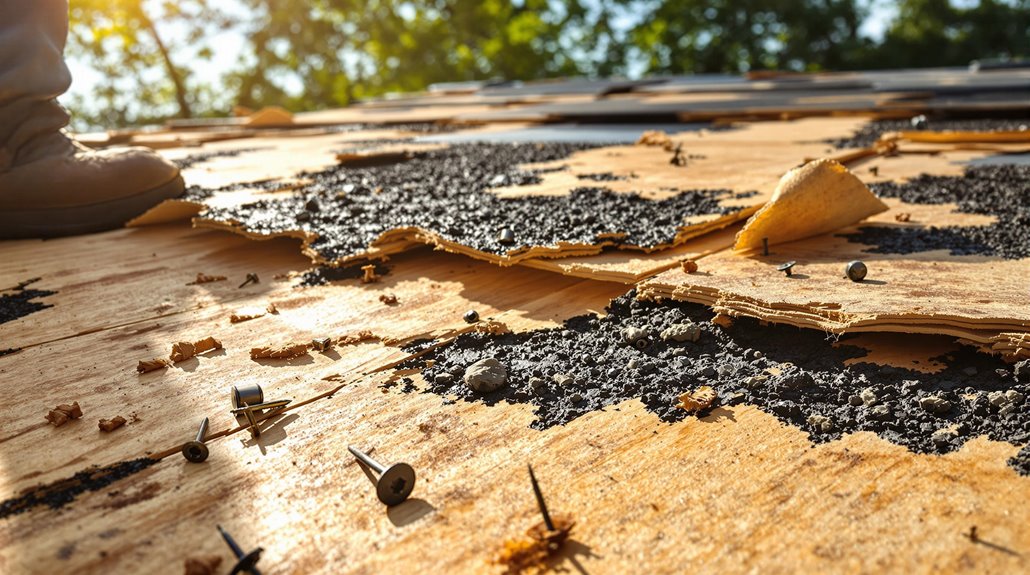
Is Your Roof's Plywood Telling You It's Time for a Change?
Think of your roof's plywood as your home's protective helmet – when it's compromised, you're in for trouble. Let's explore those telltale signs that scream "replace me!"
First up, take a peek at your roof's silhouette. Notice any sections doing the wave? That sagging isn't a design feature – it's your plywood crying for help.
And if you're spotting mysterious water stains dancing across your ceiling or catching glimpses of daylight through your attic's roof deck, your plywood's sending up red flags.
Ever feel like you're walking on marshmallows when you're up on your roof? That sponginess under your feet isn't giving you extra bounce – it's actually a serious warning sign of deteriorating plywood.
Think of it as your roof's version of a stress test.
The moisture monster can wreak havoc on your plywood, leaving behind some unmistakable calling cards:
- Delaminating layers peeling apart like old wallpaper
- Boards warping into fun-house mirror shapes
- Uninvited guests like mold and mildew setting up camp
- Dark, crumbly patches that feel as sturdy as wet cardboard
Your local roofing pro might also check how well your plywood's holding onto its nails.
If those nails are playing "easy out," you're looking at plywood that's lost its grip on life.
And let's not forget about those sneaky termites – if they've been treating your roof like an all-you-can-eat buffet, it's definitely replacement time.
When filing an insurance claim, remember that catastrophic events are typically covered by most insurance companies.
Cost Factors When Including Plywood Replacement
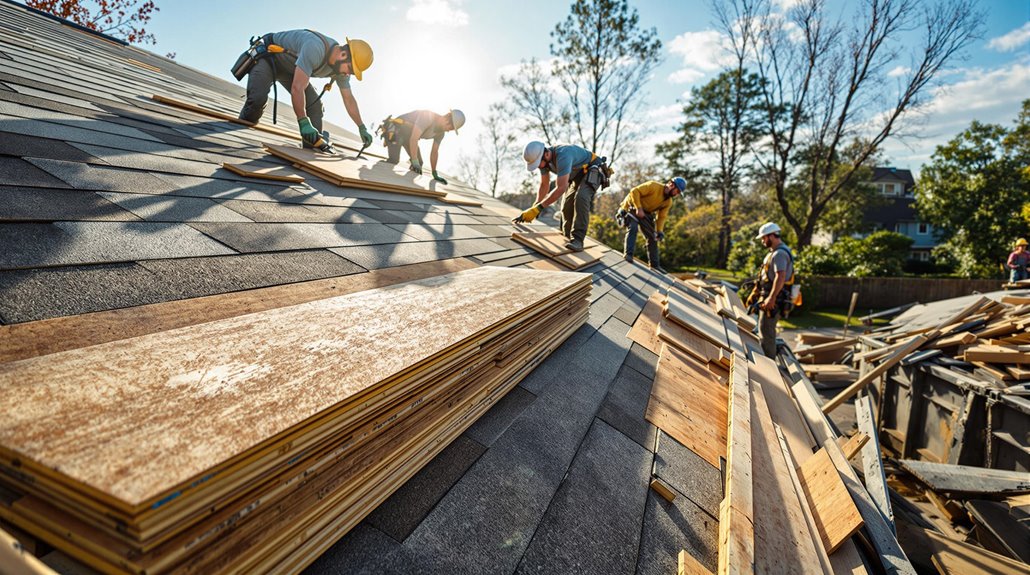
Is Your Roof's Plywood Making Your Wallet Nervous? Let's Talk Numbers!
When it comes to roof repairs, that sneaky plywood beneath your shingles can be a real game-changer for your budget. Think of it as the foundation of your roofing sandwich – and just like finding a surprise in your lunch, discovering damaged plywood during a roof job can serve up some unexpected costs.
Breaking Down the Plywood Puzzle:
Labor Costs: Your skilled roofers will charge $45-75 per hour to tackle this job – after all, they're not just slapping down boards; they're crafting your home's shield against Mother Nature.
Material Matters: Quality plywood sheets run between $25-45 each, depending on whether you're going for the basic protection or premium-grade armor for your home.
Size Considerations: Every square foot counts at $4-8, which really adds up when you're covering your castle.
The Hidden Players:
- Dumpster fees and disposal costs ($100-300)
- Building permits ($150-500) – because even your roof needs paperwork
- Unexpected structural issues (the "while we're up here" discoveries)
Pro Tip: Your insurance might be your best friend here – if storm damage caused the plywood problems, you could be looking at significant coverage. But remember, every policy tells a different story, so check yours carefully.
Think of plywood replacement like a doctor's visit – catch the small issues early, and you'll save yourself from bigger headaches down the road.
Working with a public adjuster's services can increase your claim payout by 20-50% when filing for roof damage.
Want to keep costs in check? Consider timing your project during the off-season when crews are less busy, and don't forget to factor in your location's impact on labor rates.
The Benefits Of Consulting A Public Adjuster
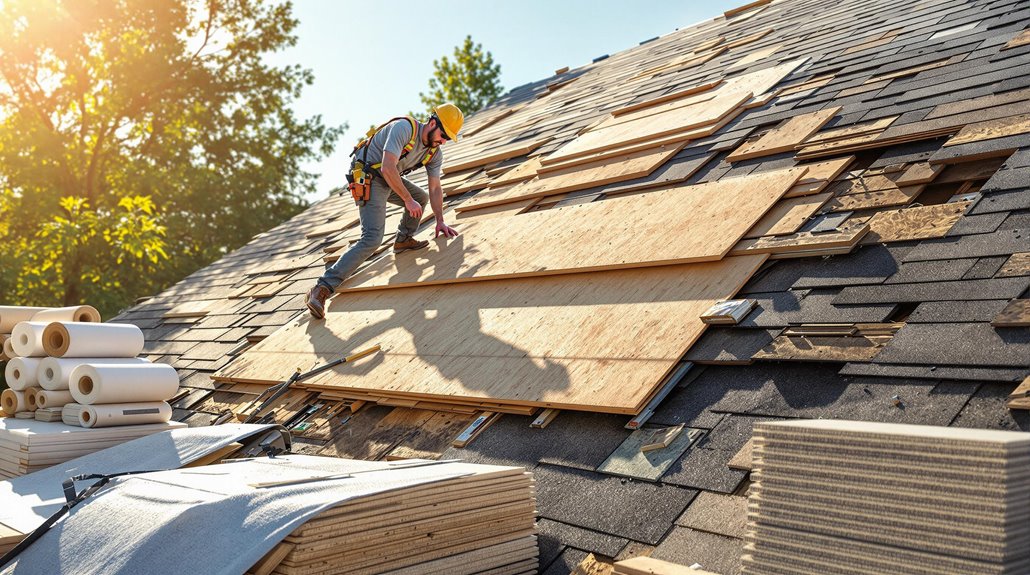
Consulting a public adjuster during a roof and plywood replacement project provides access to specialized expertise in insurance claims assessment and policy interpretation.
Professional public adjusters conduct thorough, objective evaluations of roof damage and necessary plywood replacements, documenting all findings to maximize claim potential.
Their involvement typically results in higher settlement amounts through skillful negotiation with insurance providers while streamlining the overall claims process for property owners.
Studies show that public adjuster settlements average 800% higher compared to independently filed insurance claims.
Expertise In Insurance Claims
Think of public adjusters as your personal insurance claim superheroes – they're the pros who fight for your rights when roof damage turns your world upside down. While tackling an insurance claim alone might feel like climbing a mountain in flip-flops, these licensed experts know exactly how to navigate the journey.
Ever wondered why some homeowners walk away with dramatically better settlements? Public adjusters typically help secure payouts that can dwarf what you'd get on your own, sometimes reaching up to 800% more than DIY claims. They're like having a GPS through the maze of insurance paperwork!
What makes them so effective? They speak "insurance language" fluently and know every corner of your policy inside and out. From documenting that tricky wind damage to spotting hidden issues your insurer might miss, they're like CSI investigators for your roof – leaving no shingle unturned.
When your claim gets complicated (and let's face it, they usually do), these specialists become your strongest advocates.
They'll:
- Conduct eagle-eyed damage assessments
- Create bulletproof documentation
- Handle those nerve-wracking negotiations
- Keep your claim moving while you focus on getting back to normal
Ready to stop wrestling with insurance companies and let a pro take the wheel? A public adjuster might be exactly what you need to turn that stressful claim into a success story.
For catastrophic or complex claims, adjusters may charge up to 30% of the settlement based on the required expertise and time investment.
Objective Damage Assessment
Want to know the secret behind successful insurance claims? It all starts with a rock-solid damage assessment – think of it as your property's medical check-up, but for your roof!
Let's talk about public adjusters, your personal property advocates who dig deeper than meets the eye. These pros meticulously scan every nook and cranny of your roof damage, from those tricky plywood issues to hidden structural concerns.
They're like property detectives, armed with cameras and clipboards, documenting everything that Mother Nature threw at your home.
Here's the game-changer: while insurance company adjusters might wear two hats (looking out for both you and their employer), public adjusters are 100% in your corner. They speak the complex language of insurance claims fluently and translate it into compelling evidence for your case.
Real-world results show their impact is substantial – claims handled by public adjusters often secure settlements up to 8 times higher than DIY claims.
Think of them as your roof's storytellers, crafting a detailed narrative of the damage through high-resolution photos, comprehensive reports, and expert analysis.
They're not just looking at today's problems; they're considering how that small leak might become tomorrow's headache. This thorough approach isn't just about getting you fair compensation – it's about protecting your home's future.
With 24-hour response times guaranteed, you'll never be left wondering about the status of your claim.
Streamlined Claim Process
Want to Turn Your Insurance Claim into a Success Story? Enter the Public Adjuster!
Think of public adjusters as your personal insurance claim champions – they're like having a GPS system that guides you through the maze of paperwork while fighting for every dollar you deserve. And boy, do they deliver! We're talking about potential settlement increases that could make your jaw drop (some seeing up to 800% more), which explains why their 10-20% fee is often worth its weight in gold.
Ever tried juggling damage assessments, cost calculations, and insurance negotiations while dealing with property damage? It's like trying to solve a Rubik's cube in the dark. That's where these claim wizards shine! They roll up their sleeves and:
- Photograph and document every scratch, dent, and crack
- Crunch numbers with surgical precision
- Build bulletproof claim packages that insurance companies can't ignore
What's really cool is how they transform the overwhelming into the manageable. While you focus on getting your life back to normal, your public adjuster is in the trenches, speaking the insurance industry's language and turning complex claims into clear victories.
They're particularly clutch when things get messy – think major disasters or those head-scratching coverage disputes. It's like having a seasoned chess player plan your moves while you catch your breath.
They know the game, anticipate the challenges, and strategically position your claim for optimal results. No more stumbling through insurance jargon or second-guessing your settlement offer!
As members of the Public Claims Adjusters Network, these professionals undergo mandatory yearly audits to maintain the highest industry standards.
Higher Claim Payouts & Settlements
Want to know the real game-changer in insurance claims? Let's talk about public adjusters and their impact on your wallet.
Think of public adjusters as your personal claim champions – they're like having a seasoned poker player at your side when you're dealing with insurance companies. The numbers speak volumes: policyholders who team up with these pros can secure settlements that are dramatically higher than going solo.
But here's the interesting part: while their fees typically range from 10-20% of your settlement, it's often like spending a dollar to make five. These experts dig deep into the fine print of your policy, uncover hidden benefits, and speak the complex language of insurance that most of us find mind-boggling.
Picture them as insurance detectives – they'll investigate every nook and cranny of your damage, from that tricky roof leak to the not-so-obvious structural issues hiding beneath the surface. They're particularly skilled at spotting those easily missed details, like compromised plywood under shingles, that could make or break your claim's value.
What sets them apart? Their systematic approach turns what might seem like a straightforward claim into a comprehensive case for maximum compensation. They know exactly what documentation carries weight, how to present evidence effectively, and when to push back on lowball offers. It's like having a translator who speaks fluent "insurance-ese" working for you!
About The Public Claims Adjusters Network (PCAN)

Think of PCAN as your insurance claim superhero squad! We're talking about the Public Claims Adjusters Network – a powerhouse team of licensed pros who've got your back when property damage turns your world upside down.
Ever wondered who fights for your rights when insurance claims get messy? That's where we come in. Our network isn't just any group of adjusters – we're the cream of the crop, handpicked through a rigorous selection process that would make talent scouts jealous.
What makes PCAN stand out in the insurance jungle?
- We've got boots on the ground in over 40 states
- Our experts handle everything from hurricane damage to fire losses
- Each member goes through yearly checkups (think of it as our quality control superpowers)
You wouldn't trust your health to just any doctor, right? The same goes for your property claims. Every PCAN member has passed our comprehensive vetting process, proving they're not just licensed – they're absolutely stellar at what they do.
Whether you're dealing with a flooded basement in your home or storm damage at your business, our network connects you with battle-tested professionals who speak 'insurance language' fluently.
We're like your personal translators in the complex world of claims, making sure you get what you deserve.
Remember: When disaster strikes, having a PCAN adjuster in your corner is like having a GPS through the insurance maze – we'll help you navigate to the best possible outcome!
Frequently Asked Questions
How Long Does Plywood Installation Add to the Total Roof Replacement Timeline?
Plywood installation duration typically adds 1-2 days to roof replacement projects. Extensive deck repairs or adverse weather conditions can extend project delays by an additional 2-3 business days.
Can I Replace Only Specific Sections of Damaged Roof Plywood?
While 60% of roof repairs involve partial plywood replacement, contractors can effectively replace individual damaged sections, provided surrounding plywood quality remains intact and proper moisture barriers are maintained.
What Thickness of Plywood Is Typically Used for Roof Replacement?
Standard roof plywood thickness ranges from 7/16 inch to 3/4 inch, with 1/2 inch being most common. Higher plywood grades provide better roof stability, with CDX grade typically meeting residential requirements.
Are There Alternatives to Plywood That Work Better for Roof Replacement?
With 15% cost savings over plywood, OSB panels offer strong durability for roof decking. Fiberglass sheets provide lightweight alternatives, while metal decking systems deliver superior moisture resistance and longevity.
How Does Climate Affect the Choice of Plywood for Roof Replacement?
Climate considerations greatly impact plywood selection, as moisture levels affect material durability. Hot regions require moisture-resistant grades, while cold climates need panels that resist warping and delamination under freeze-thaw cycles.



